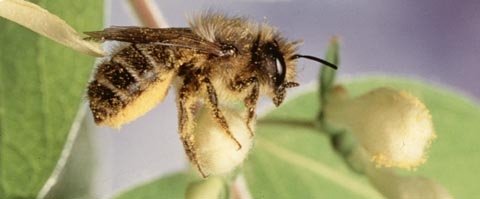
Hornfaced bee (Osmia cornifrons). Photo by Dr. Suzanne Batra
A bee that seems to have a penchant for flying in cool and cloudy weather is causing quite a buzz among scientists and orchardists, who believe it has promise as a tree fruit pollinator.
The hornfaced bee (Osmia cornifrons), used for decades to pollinate Japanese orchards, is gaining popularity as replacement or supplement for honeybees. The hornfaced bee, related to the mason bee, is attracting attention from researchers in Michigan, Utah, Virginia, and West Virginia, and even home gardeners because it is efficient, easy to handle, prefers fruit pollen, may fly under cool conditions, and is unaffected by the mites and diseases that are causing problems in the commercial honeybee industry.
Dr. Nikki Rothwell, district integrated pest management educator for Michigan State University, said they are studying hornfaced bees to see if fruit set of Balaton cherries can be increased.
Balaton, called the “sweet tart cherry” by Michigan growers, was brought to the United States in the mid-1980s by MSU’s Dr. Amy Iezzoni. It is a plump, firm cherry, with fruit and juice a dark burgundy color. Michigan growers see potential for the fresh market with Balaton cherries.
But the variety suffers from low yields, especially during years with cool, wet springs. Over the past few years, fruit set in Balaton has been disappointing. Field observations suggest that cool temperatures during bloom may be contributing to poor fruit set.
Research
Rothwell began a trial in 2005 to learn more about hornfaced bees and their pollinating habits. Two nesting buckets of hornfaced bees were placed into half of a block of Balaton cherries in mid-May, while the other half of the block went without hornfaced bees and was beyond the bees’ foraging range. Flowers on 30 branches were counted and recorded, and the number of fruit on all branches was counted after June drop. Eight locations were included in the study.
Several orchards had significantly higher fruit set counts in the hornfaced block, she explained, but the yields were not significantly higher than the control.
As part of the research, Rothwell and her colleagues spent many hours in the orchard watching bees and their behavior to learn how to better manage pollination.
“We counted the amount of time bees spent on each flower and the number of flowers they visited,” she said. On average, the hornfaced bee spent 12 seconds at each flower, while the honeybee visited each flower for 4 seconds. However, honeybees visited more flowers per tree, averaging 7.7 flowers per tree, compared to 3 flowers per tree by the hornfaced bees.
Preliminary data shows that hornfaced bees as well as bumblebees fly under cooler temperatures and cloudy skies. The willingness to fly during cool temperatures is one of the reasons that the hornfaced bees may be beneficial to cherry growers, Rothwell said, noting that data is still preliminary. Pollination may also be improved because the hornfaced bees spend more time per flower and do a more thorough job of pollination.
Yields from Balaton cherries pollinated by hornfaced bees did not differ significantly from honeybee-pollinated yields, she added.
One advantage of using hornfaced bees is that growers don’t have to rent the bees. The hives can be purchased and easily stored in a shed in five-gallon containers until the next pollinating season.
“You need about 250 nesting females per acre—far fewer than the number of honeybees needed,” she said.
Rothwell noted that when hornfaced bees first wake up from their winter dormancy, they spend most of their time mating.
Why hornfaced bees?
Josh Wunsch, apple and cherry grower in Traverse City, Michigan, was looking for a more reliable way to pollinate his dark, sweet cherries grown for the fresh market when he came across an article in the New York Times some five years ago. The article described the habits and pollinating behavior of solitary bees, specifically the blue orchard bee, which is also known as the hornfaced bee.
“The pollination of cherries is very mysterious,” he said. “It’s been my observation that in cold, wet, windy weather conditions during pollination, honeybees don’t tend to do as well, and fruit set suffers. But in other pollination conditions when conditions seem to be perfect, I can still have a pathetic offering of fruit.”
But generally, he attributes poor fruit set to cold, wet, and windy bloom conditions.
Wunsch used the Internet to find a source of the hornfaced bees in the Midwest and ordered about a dozen five-gallon buckets with cardboard tubes full of eggs and mud. He hung the buckets up in trees during bloom and watched the bees come out.
While he did see bees pollinating during adverse weather, he had a poor turnout in the reproduction area. The buckets were not full of eggs when they were placed in storage after pollination.
Out of business
When Wunsch returned to the Midwest beekeeper to discuss the reproduction problems, he learned that the beekeeper wanted to get out of the business. Michigan State University then became the recipient of about 500 five-gallon buckets of donated hornfaced beehives.
Some 35 Michigan tree fruit growers received hornfaced bees to test in their cherry and apple orchards, said Rothwell, who organized the giveaway project. Some of the hives were kept for Rothwell’s research trials.
The bee donation, in addition to providing MSU with bees for experiments, enabled her to put a significant number of bees in growers’ hands for testing and feedback. This will be the second year of collecting data on the hornfaced bees.
Rothwell noted that more research is needed to determine optimum time of placement in the orchard and to further evaluate their potential. She is seeking additional grant money for research.

Leave A Comment